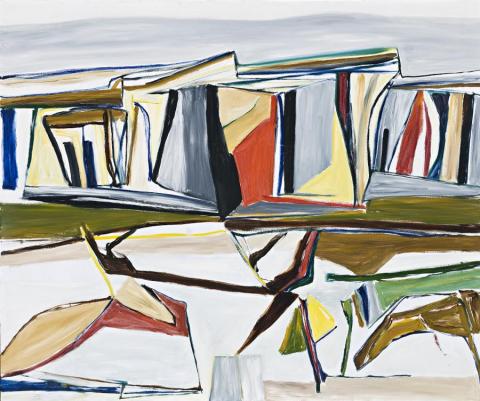SOUTHERN EUROPEAN LANDSCAPE NO 1
Ken Whisson
oil on canvas
99.0 x 119.0 cm
Niagara Galleries, Melbourne
Private collection, Melbourne, acquired from the above in February 2000
Fundamental to the highly enigmatic, gestural form of abstraction for which Ken Whisson has become renowned is the premise that art should be produced with intuitive spontaneity. As illuminated in his lecture on 'Technique and Intuition' at the Ballarat Art School in 1994, Whisson believes artistic creation reaches its zenith in the moment where the artist's conscious eyes and mind are totally surprised by what the brush has intuitively produced: '...By not looking at your own work you don't lose the thread of development, the ideas and developments come back from that dark pile of hidden paintings in a way that they will not come back if you look at them and wonder about them, have doubts, or worse, let them seduce you into thinking that what you have already done is your style and way of painting.'1
Interestingly, this honest and unpretentious approach to painting has resulted in a truly sophisticated, complex visual language that exerts increasingly compelling appeal on the viewer. Images which initially appear disordered and unrelated, floating in spatial ambiguity, suddenly become recognisable; as John McDonald observes, '...Looking at one of Whisson's works is like studying a diagram of the thinking mind. This is why their schematic forms begin to seem ever more familiar over time - they conjure up experiences and observations that virtually everyone holds in common... The idiosyncratic colours and raw insistent marks with which Whisson records these experiences do not completely disguise the nature of each scene. On the contrary, they invite us to interpret these views as filtered through another consciousness.'2
Accordingly, far from objectively representing an actual locale Southern European Landscape No.1 is imbued rather with Whisson's personal responses to the scene - including, no doubt, recollections of his Australian homeland and echoes of the rural landscape surrounding his adopted home in Perugia. Evoking the travelogue genre, indeed the images imprinted on his memory appear on the canvas in the manner of a discontinuous slide show where planes and objects are simultaneously established and disrupted. Thus oscillating between figuration and abstraction, the work encapsulates the artist's enduring preoccupation with merging figure and ground relationships to create a visually dynamic arrangement that encourages 'the viewer to see with the eye of the mind rather than expecting a perfect match between an object and its representation.'3
1. Whisson, K., 'Talk 1994' reproduced in Ken Whisson: Paintings 1947-1999 with Writings and Talks by the Artist, Niagara Publishing, Melbourne, 2001, p. 43
2. McDonald, J., 'Introduction', cited ibid., p. 9
3. ibid.
VERONICA ANGELATOS
